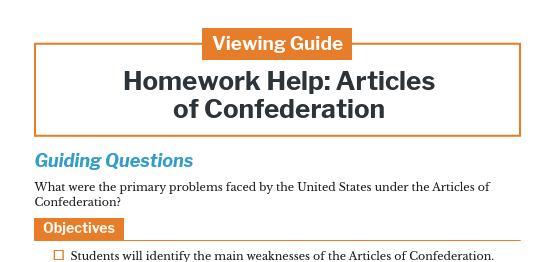
Homework Help: Articles of Confederation Viewing Guide
Guiding Question:
- What were the primary problems faced by the United States under the Articles of Confederation?
Objectives
- Students will identify the main weaknesses of the Articles of Confederation.
- Students will understand how these weaknesses affected the early United States.
Anticipate
- Introduce that the class will be watching a short video about the “Articles of Confederation.
- Break down the title by asking students to define the words “article” and “confederation.”
- Ask: Have you seen the word “article” before? Where?
- Possible student responses: Newspaper articles, magazine articles, sections in a document.
- Explain that an article can mean a written section of a document or a piece of writing about a topic.
- Ask: Have you heard the word “confederation” before? What do you think it means?
- Break it down:
- Confed- comes from the Latin word confoederatus, meaning “joined together.”
- Confederation – A group of states or nations that agree to work together.
- Relate to today: Can you think of any modern examples of confederations? (e.g., European Union, sports leagues, alliances)
- Ask: Based on what we discussed, what do you think “Articles of Confederation” means?
- Possible student responses: A written agreement that joins states together.
- Preview some key vocabulary and terms. Remind students to listen for these words in the video.
- Separation of powers: Each division of government exercises distinct powers to carry out its functions and to prevent the accumulation of power.
- Checks and balances: The branches of government each have powers to limit the powers of the other branches and to prevent any branch from becoming too powerful.
- Federalism: The national and state governments have a balance of separate and shared powers. The people delegate certain powers to the national government, while the states retain other powers; and the people retain all powers not delegated to the governing bodies.
Scaffolding Note: If any words are used in the video and the student does not know them, instruct them to write the words down so you can define them after the video.
Engage
- Have students write the essential question at the top of their page:
“What were the primary problems faced by the United States under the Articles of Confederation?” - Then, have them fold their paper in half vertically (hotdog style) for note taking:
- Left side: List weaknesses or problems of the Articles of Confederation.
- Right side: Take notes, draw diagrams, or jot down questions.
Explore
- After watching the video, ask students to review the notes they took. Then have them discuss any key points or questions with a partner.
- You may help guide discussions with the following questions:
- What were the biggest challenges under the Articles of Confederation?
- How did the Articles limit the power of the national government?
- Why were the states given so much power?
- What problems did the weak national government create?
- How did these weaknesses lead to the creation of the Constitution?
Reflection
- Depending on the skills and needs of students, use the following reflection strategies.
- Ask students to pretend they are explaining the weaknesses of the Articles of Confederation to a younger student. Have them write down a 1-minute speech in their own words.
- Ask students to sketch a quick picture or symbol that depicts the failures of the Articles of Confederation.
- Examples: A weak bridge collapsing (representing a weak government); a tug-of-war between states (representing lack of unity); or, a box with missing pieces (representing incomplete government structure).
